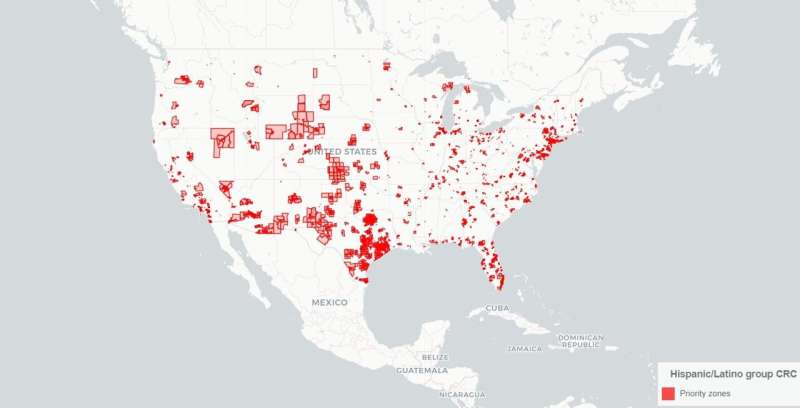This article has been reviewed according to Science X's editorial process and policies. Editors have highlighted the following attributes while ensuring the content's credibility:
fact-checked
peer-reviewed publication
trusted source
proofread
Research identifies priority zones that may help improve colorectal cancer screening among Hispanic/Latino individuals

Cleveland Clinic-led research has identified geographic areas in the United States where strategic efforts to promote colorectal cancer screening could help reduce health care gaps affecting Hispanic/Latino communities.
The study, published in the American Journal of Public Health, marks a first step toward conducting larger neighborhood-level studies addressing disparities in colorectal cancer screening.
The Hispanic /Latino population has the lowest colorectal cancer screening rate among U.S. racial and ethnic groups as defined by the U.S. Census Bureau. Lower screening rates often lead to later diagnoses, advanced cancer stages and poorer treatment outcomes.
The researchers identified "hot spots" across the country where larger percentages of Hispanic/Latino populations are associated with lower colorectal cancer screening rates. Based on this information, they developed an interactive web map illustrating their findings. This is the first study to conduct a nationwide geographic analysis to identify local priority zones with the goal to increase colorectal cancer screening in those Hispanic/Latino communities.
"This approach advances our ability to pinpoint neighborhoods that may benefit from targeted education or intervention programs, taking into account unique characteristics, such as cultural values and language," said study first author Blake Buchalter, Ph.D., a post-doctoral fellow in Cleveland Clinic Lerner Research Institute. "The primary objective of this research is to identify key areas where targeted efforts could have the maximum impact on improving colorectal cancer screening among Hispanic and Latino individuals, based on their region or country of origin."
To better understand community-level colorectal cancer screening disparities, Dr. Buchalter engaged a team of researchers in analyzing publicly available cancer screening and census databases to gauge colorectal cancer screening rates in neighborhoods across the country.
The interactive map the team built provides a tool for public health authorities, policymakers, clinicians and other stakeholders to target investments and interventions to increase screening uptake in the areas where it is needed most.
The results are classified by Hispanic/Latino region or country of origin (e.g., Mexico, Puerto Rico, Central/South America, Dominican Republic and Cuba) as reported to the U.S. Census Bureau.
"It's important to remember that Hispanic/Latino communities are incredibly diverse with respect to many factors, such as ancestry, culture and health behaviors," said principal investigator and senior study author Stephanie Schmit, Ph.D., M.P.H, vice chair of Genomic Medicine at Cleveland Clinic and acting associate director for Cancer Population Sciences in the Case Comprehensive Cancer Center. "Informed action is impossible without recognizing the diversity and heterogeneity of these communities."
"The factors that contribute to screening disparities are not universal," Dr. Schmit said. "Some people are impacted by financial constraints or access to health care facilities, while others may be impacted by language barriers or a lack of trust in medical institutions. To better understand such barriers and how to help address them, we need to identify who is being impacted and where."
"In the long term, we hope our work will be an impetus for the scientific and biomedical communities to dig deeper into these colorectal cancer screening priority areas to understand what disparities look like on the ground," said Dr. Buchalter.
"The goal of this research is to help increase colorectal cancer screening rates in these priority neighborhoods, which will not only benefit the populations living there but also contribute to increasing the national screening rates."
Looking forward, Drs. Buchalter and Schmit hope their work will spur further discussion of public policy and community initiatives to assist in prevention in affected neighborhoods and improve access to care.
More information: Identification of Priorities for Colorectal Cancer Screening Interventions among US Hispanic/Latino populations, American Journal of Public Health (2024). DOI: 10.2105/AJPH.2024.307733

















